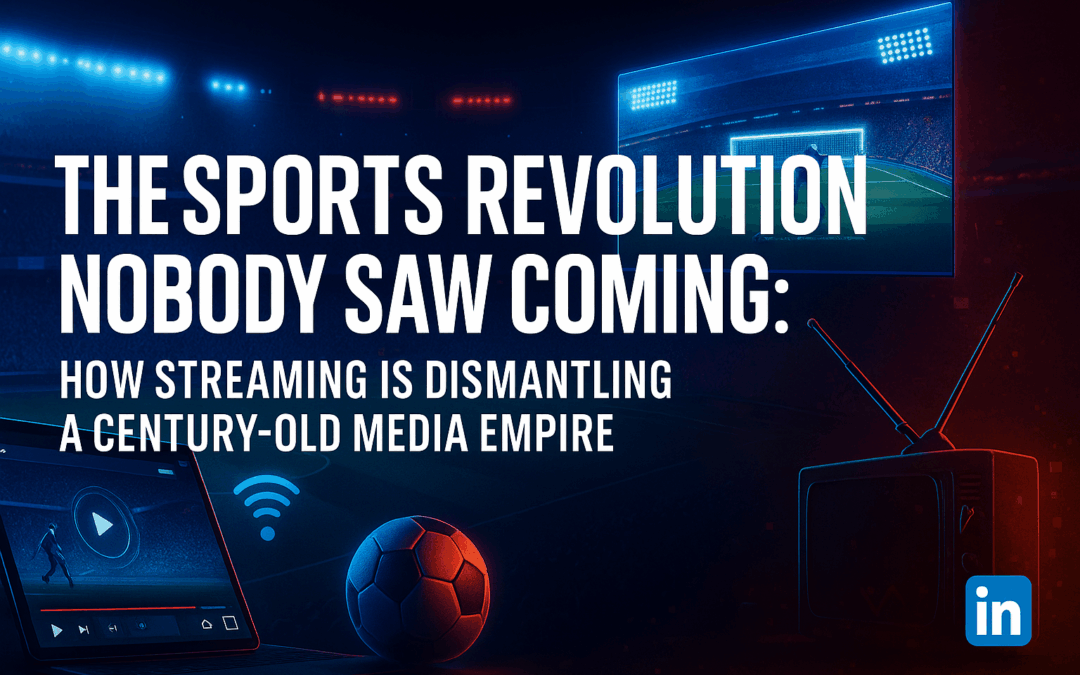The Sports Revolution Nobody Saw Coming: How Streaming Is Dismantling a Century-Old Media Empire
By Patrick Seaman
CEO @ SportsBug™ | Board Member & Advisor | Futurist | Author
The sports media landscape isn’t just evolving—it’s being torn down and rebuilt from the ground up. What we’re witnessing isn’t gradual change; it’s the systematic dismantling of a broadcast monopoly that has controlled how, when, and where we consume sports for nearly a century.
Three seemingly disconnected stories from this past week reveal the true scope of this transformation. Together, they paint a picture of an industry in the midst of its most fundamental shift since television itself.
The Billion-Dollar Bet That Changes Everything
DAZN’s $1 billion gamble on exclusive global streaming rights to the 2025 FIFA Club World Cup represents more than just another streaming deal—it’s a declaration of war against the old guard. With matching investment from Saudi Arabia’s Public Investment Fund, DAZN isn’t just buying content; they’re buying the future.
This move exposes the fatal flaw in traditional sports broadcasting: geographic limitations in a borderless digital world. While legacy broadcasters haggle over regional territories and blackout restrictions, DAZN is building a global sports infrastructure that treats the entire planet as one market.
The implications are staggering. When a streaming platform can deliver premium content directly to any device, anywhere, at any time, the entire value chain of sports media gets rewritten. Broadcasters become middlemen. Cable companies become obsolete. Fans become customers, not captives.
The Democratization of the Overlooked
On the complete opposite end of the spectrum, Pluto TV’s partnership with the All Women’s Sports Network tells an equally compelling story. Their new 24/7 FAST channel will deliver over 2,500 hours of women’s sports annually—completely free.
This isn’t charity; it’s smart business. Women’s sports have been systematically underserved by traditional media, not because of lack of interest, but because of outdated assumptions about what constitutes “profitable” content. FAST channels have shattered that equation by proving that niche audiences, when properly aggregated and monetized through advertising, can be incredibly valuable.
The math is simple: lower content costs + passionate niche audiences + targeted advertising = sustainable business model. It’s a formula that legacy broadcasters, weighed down by massive overhead and conservative programming strategies, simply couldn’t execute.
When Local Goes Global
Texas high school football might seem like the most regional story possible, but the UIL’s five-year streaming deal with Victory+ represents something profound: the globalization of hyperlocal content.
Friday night lights in small Texas towns will now reach college recruiters in California, grandparents in Florida, and sports fans worldwide who’ve never set foot in the Lone Star State. Geographic boundaries that once limited the reach of community sports have been completely erased.
This isn’t just about convenience—it’s about economic opportunity. When local sports content can reach global audiences, entirely new revenue streams emerge. Sponsorship deals expand beyond local businesses. Merchandise sales reach new markets. Recruiting becomes more democratic.
The Pattern That Changes Everything
These three stories share a common thread: the complete restructuring of who controls sports media and how value is created and distributed.
At the global level: Streaming platforms are bypassing traditional broadcasters entirely, going direct to consumers with premium content and global reach.
At the vertical level: FAST channels are proving that “niche” content can be massively profitable when you remove the barriers and gatekeepers.
At the local level: Communities are reclaiming ownership of their stories and reaching audiences they never thought possible.
This isn’t just about technology—it’s about power. For decades, a handful of networks controlled what sports we could watch, when we could watch them, and how much we had to pay. That monopoly is crumbling in real time.
The New Sports Media Reality
We’re not just witnessing the rise of streaming; we’re watching the birth of a fundamentally different entertainment ecosystem. One where geographic boundaries don’t matter. Where niche content can find global audiences. Where barriers to entry are measured in bandwidth, not billions.
The old gatekeepers are becoming irrelevant. The new winners will be those who understand that in a world of infinite content options, the most valuable thing you can offer isn’t exclusivity—it’s accessibility.
From billion-dollar global rights to Friday night lights in small Texas towns, the message is clear: the future of sports media belongs to whoever can deliver the right content to the right audience at the right time, regardless of where they are or how much they can afford to pay.
The revolution isn’t coming. It’s here. And this time, everyone gets the best seat in the house.
Continue the Conversation
How do you see Streaming media transforming your relationship with sports. Whether as a fan, athlete, or industry professional?
Streaming Wars Perspective
The quote below comes from my book Streaming Wars, which chronicles the rise of streaming from its earliest experiments at AudioNet and Broadcast.com to today’s global media empires. It captures the essence of what we’re witnessing now—a transformation that didn’t wait for legacy media to adapt. Streaming didn’t just disrupt the status quo, it bypassed it entirely, reshaping not only how content is delivered but who gets to control it. The shifts we’re seeing in global football rights, women’s sports, and high school broadcasts are all echoes of that same revolution—playing out across every level of the sports media landscape.
“The revolution wasn’t televised. It was streamed—quietly, experimentally, and then all at once. By the time the industry realized what had happened, the audience had already left the room.”
— Streaming Wars by Patrick Seaman
For deeper insights into digital media transformation trends, check out my book: Streaming Wars: From Broadcast.com to the Future of Digital Media – available on Amazon: https://amzn.to/43m14oE, and Apple Books: https://books.apple.com/us/book/streaming-wars-from-broadcast-com-to-the-future/id6746369305
#SportsTech #StreamingMedia #DigitalTransformation #MediaDisruption #FutureOfSports #SportsBusiness
#TechLeadership #MediaExecutives #StartupCulture #InnovationStrategy #LinkedInNews
#OTTStreaming #FASTChannels #DAZN #PlutoTV #UILFootball #WomenInSports #GlobalMedia
Sources:
- DAZN’s $1B Club World Cup Deal
- Pluto TV Adds All Women’s Sports Network’s FAST Channel
- Texas UIL Signs Statewide Streaming Deal

Recent Comments